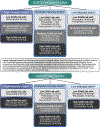The Clinical Pharmacogenetics Implementation Consortium Guideline for SLCO1B1, ABCG2, and CYP2C9 genotypes and Statin-Associated Musculoskeletal Symptoms
- PMID: 35152405
- PMCID: PMC9035072
- DOI: 10.1002/cpt.2557
The Clinical Pharmacogenetics Implementation Consortium Guideline for SLCO1B1, ABCG2, and CYP2C9 genotypes and Statin-Associated Musculoskeletal Symptoms
Abstract
Statins reduce cholesterol, prevent cardiovascular disease, and are among the most commonly prescribed medications in the world. Statin-associated musculoskeletal symptoms (SAMS) impact statin adherence and ultimately can impede the long-term effectiveness of statin therapy. There are several identified pharmacogenetic variants that impact statin disposition and adverse events during statin therapy. SLCO1B1 encodes a transporter (SLCO1B1; alternative names include OATP1B1 or OATP-C) that facilitates the hepatic uptake of all statins. ABCG2 encodes an efflux transporter (BCRP) that modulates the absorption and disposition of rosuvastatin. CYP2C9 encodes a phase I drug metabolizing enzyme responsible for the oxidation of some statins. Genetic variation in each of these genes alters systemic exposure to statins (i.e., simvastatin, rosuvastatin, pravastatin, pitavastatin, atorvastatin, fluvastatin, lovastatin), which can increase the risk for SAMS. We summarize the literature supporting these associations and provide therapeutic recommendations for statins based on SLCO1B1, ABCG2, and CYP2C9 genotype with the goal of improving the overall safety, adherence, and effectiveness of statin therapy. This document replaces the 2012 and 2014 Clinical Pharmacogenetics Implementation Consortium (CPIC) guidelines for SLCO1B1 and simvastatin-induced myopathy.
© 2022 The Authors. Clinical Pharmacology & Therapeutics © 2022 American Society for Clinical Pharmacology and Therapeutics.
Conflict of interest statement
CONFLICTS OF INTEREST
THE AUTHORS DECLARED NO COMPETING INTERESTS FOR THIS WORK.
Figures
References
-
- Grundy SM et al. 2018 AHA/ACC/AACVPR/AAPA/ABC/ACPM/ADA/AGS/APhA/ASPC/NLA/PCNA Guideline on the Management of Blood Cholesterol: Executive Summary: A Report of the American College of Cardiology/American Heart Association Task Force on Clinical Practice Guidelines. J Am Coll Cardiol 73, 3168–209 (2019). - PubMed
-
- Niemi M, Pasanen MK & Neuvonen PJ Organic anion transporting polypeptide 1B1: a genetically polymorphic transporter of major importance for hepatic drug uptake. Pharmacol Rev 63, 157–81 (2011). - PubMed


